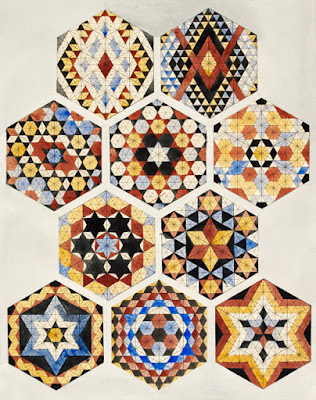Morris Hexathon 14: Canterbury by Becky Brown
Morris Hexathon 14: Canterbury
3 Templates:A hexagon, a 60 degree diamond and a long parallelogram.
I named this week's hexie Canterbury for England's famous cathedral.
When William Morris was eight years old his father took him to visit the ancient church, which was begun about 1200 in the new style that came to be called English Gothic.
14: Canterbury by Ilyse Moore
A ceiling
A floor
The cathedral is one of the earliest examples of English Gothic architecture.
Pointed arches are a style detail,
as are vaulted arches in the ceilings.
The impressive vault is held up by outside supports.
Those arches extending out from between the windows are
called Flying Buttresses, another characteristic of Gothic architecture.
Pattern for an 8" Hexagon
(4"
sides)
To Print:
- Create a word file or a new empty JPG file that is
8-1/2" x 11".
- Click on the image above.
- Right click on it and save it to your file.
- Print that file out 8-1/2" x 11". The hexagon
should measure 4" on the sides.
- Adjust the printed page size if necessary.
- Add seams when you cut the fabric.
Canterbury by Bettina Havig
Canterbury by Ilyse Moore
Ilyse did two.
The pattern, BlockBase #264, was given the name Pinwheel in the Kansas City Star in 1934 but to remember Morris's fondness for the Gothic we could see the image as the Flying Buttresses that hold up Canterbury Cathedral.
Using just two of the pattern pieces you could make a double pinwheel.
In later life as an influential preservationist Morris had strong opinions about the maintenance and changes in Canterbury Cathedral. He wrote letters to The Times:
"For my part, remembering well the impression that Canterbury Cathedral made on me when I first stood in it as a little boy, I must needs think that a great building which is obviously venerable and weighty with history is fitter for worship than one turned into a scientific demonstration of what the original architects intended to do."His position essentially: Keep a roof on it and leave it alone.
Canterbury Cathedral
One More Inspiration
Owen Jones published an extremely influential book on pattern in 1853.
There's a page above
and here's the whole book The Grammar of Ornament at Google Books:

















Thank you
ReplyDeleteI like the use of colors in Bettina's Canterbury, the white showcases the colors and pattern.
ReplyDeleteWow! Just came across this in my Pinterest feed. What an incredible pattern! I can see it done it light and dark fabrics to create a three dimensional look. Thank you so much for sharing.
ReplyDelete